Emilie Johnson
Emilie Johnson was a Swedish-American author, scenarioist and movie producer. She was the mother of American actor, director, producer, and writer Emory Johnson. In 1912 he dropped out of college and embarked upon his new career in the movie business. Emory started working for Essanay Studios as an assistant camera operator.[1]
Emilie Johnson | |
|---|---|
 | |
| Born | June 3, 1867 |
| Died | September 23, 1941 (aged 74) Hollywood, Los Angeles, California |
| Occupation | Writer, scenarioist, producer |
| Years active | 1914–1930 |
| Children | Emory Johnson |
In 1913, Emilie and her husband moved from San Francisco, California to Essanay company bungalows in Niles, California to support her son. In 1915, she started writing stories for the screen.[2]
In the 1920s, Emilie Johnson and her son became famous as the only mother-son directing/writing team in Hollywood. She wrote all of the stories and screenplays her son used for his successful career in directing melodramas. The Johnson team continued producing melodramas until the late twenties. By the early thirties, their string of successes had ended. Emilie died in Los Angeles, California in 1941. She was living with her son at the time of her death.
Early life
Emilie Johnson was born Emilie Matilda Jönsdotter in Gothenburg, Västra Götaland, Sweden on June 3, 1867. When she was eight years old, her school in Karlskrona was visited by a Church of Sweden Lutheran minister. As part of his tour, he read three stanzas of poetry written by young Emilie Jönsdotter. Impressed, he asked her parents if they would consider letting him adopt Emilie. If they consented, the minister would then assume the responsibility for her upbringing and education. The minister was an up-and-coming member of the Lutheran Church and a prominent writer in Sweden. Emilie's parents, realizing the minister could provide educational opportunities they could never afford, agreed to the arrangement. The minister became a bishop and eventually became an adviser to the King of Sweden.[2]
Emilie's education continued until the bishop died. After the bishop's passing, she migrated to America. She arrived in San Francisco, California on September 24, 1891. She was 25 years old and unmarried. While living in San Francisco, she met Alfred Johnson. Alf and Emilie fell in love and married at the Ebenezer Lutheran Church in San Francisco, California on May 11, 1893. Their only child, Alfred Emory Johnson, was born on March 16, 1894, in San Francisco.
In 1900, the Johnson family was living comfortably on Bush Street in San Francisco, California. Emilie's husband owned a famous Turkish bathing house. The family lived in a fine house and had live-in servants.[3] In 1906, the catastrophic San Francisco earthquake changed everything. The quake caused numerous fires throughout the city. One fire destroyed Johnson's bathhouse. The Johnsons survived the quake and resettled in nearby Alameda, California.
By 1910, Emilie's husband supported the family by helping to establish the famous Piedmont baths.[4] Emilie continued to raise their son, and attended California College of the Arts as an art major.
In 1912, Emilie's teenage son Emory Johnson entered the movie business as an assistant cameraman. Later, he signed a movie contract with Essanay Studios. In 1913, to more closely support their son's blossoming movie career, Emilie and her husband moved to one of the newly built Essanay bungalows in Niles, California.[5]
First chapter
In 1914, the Liberty Motion Picture Company was founded in Germantown, Pennsylvania. Five months later, the company reorganized into the Liberty Film Mfg Company with offices located in San Mateo, and Glendale, California.
This year, Emilie Johnson started writing scenarios for the silver screen.[2] Later she would meet and befriend a leading actress of Liberty Film Mfg. Co - Swedish actress Sadie Lindblom. Together, they believed they were looking at an opportunity in the movie business. In addition to writing stories for the screen, they could exercise even more control by producing their films.[6]
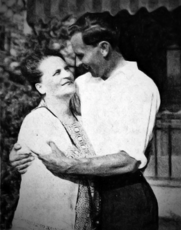
In keeping with their new strategy on writing and producing films, the Liberty Film Company was incorporated in Oakland, California. The papers were drawn up, and the following individuals declared a capital stock investment of $25,000 (over $600,000 in today's money): Emilie Johnson (age 51), Alfred Johnson (age 54), Emory Johnson (age 21), Tillie Hall and Sadie Lindblom (age 25). Lindblom would be the new president.[7]
Liberty Film Company began releasing films early in 1915 using the Kriterion Film Corporation as their releasing agent. By June 1915, Kriterion was having cash flow problems, then went bankrupt and left Liberty Film with a $40,000 debt.[6] After choosing a new releasing agent - Associated Service, Liberty Film Mfg Co struggled on.
The Liberty Film Company completed several movies.[6][8]
In late 1914, many actors and actresses started to leave Essanay Studios. Many switched to Liberty Film. Several factors precipitated the talent exit, including Essanay's continuing refusal to make more feature-length movies, and the fact that Essanay was losing money. Included in the exit was Emilie's son. Emory Johnson's last film for Essanay was released in June 1914. On February 16, 1916, the Niles Essanay studio closed and locked its doors.[9]
Liberty Films struggled with their new distributor. In December 1915, the courts appointed a new receiver. Liberty's Pennsylvania plant burned to the ground in 1916.[10][11] At the beginning of 1916, Emory left Liberty and signed a contract with Universal Film Manufacturing Company. He made 19 movies in 1916.
1917 marked another noteworthy event for the Johnsons. In September, Emory Johnson, still under contract to Universal, married Universal ingenue Ella Hall.[12] After their honeymoon, they both returned to work at Universal.[13] Newlywed Ella then moves into the Franklin Avenue house along with Emory, Emile, and two servants. Grandson Walter Emory was born in January 1919. Alfred Bernard followed in September 1920.[14]
Hollywood decade
1921
_-_1.jpg)

This would be a watershed year for 54-year-old Emilie Johnson. Previously, she had written the story "Blind Hearts". The story takes place in 1898. The tale unfolds as two men are traveling with their wives to Alaska seeking fame and fortune. Hobart Bosworth Productions purchased the story. The film version was released in October 1921 and starred Hobart Bosworth and Wade Boteler.[15][16]
That same year, Hobart Bosworth Productions picked up another Emilie Johnson vehicle - The Sea Lion. This was a tale of adventure, romance, and intrigue aboard a whaling vessel sailing in the high seas. The movie version was released in December 1921. The Sea Lion starred Hobart Bosworth, Bessie Love and Emory Johnson.[17][18]
1922

_-_2.jpg)
Emilie and her son had originally contracted with Robertson-Cole to write, produce and direct The Midnight Call. Then R-C was acquired by FBO. On July 1, 1922, the Robertson-Cole Distribution company became known as FBO. All R-C contracts were honored, especially with independent producers like Emory Johnson.[19] In May, the Riverside Independent Enterprise published an article stating Emilie had written 19 scenarios.[2]
The first Johnson collaboration under the renamed FBO contract was The Midnight Call, which was renamed In the Name of the Law. The film was released in August 1922. Emilie Johnson was credited with both the story and screenplay for this melodrama. The story is about a San Francisco policeman trying to keep his family together while facing continuing adversity.[20][21]
In December, FBO released The Third Alarm, formerly titled The Discard. This film is the second under the FBO contract. Emory directed this Emilie Johnson story about a fireman forced into retirement who later makes a triumphant return to save the day. It had spectacular scenes of burning buildings and courage-fueled firemen. The film would become the most financially successful movie ever produced in Johnson's career.[22][23]
Emilie had four of her stories shown simultaneously:[2]
- Blind Hearts, released October 3, 1921
- The Sea Lion, released December 5, 1921
- In the Name of the Law (aka The Midnight Call), released August 22, 1922
- The Third Alarm, released December 31, 1922
1923
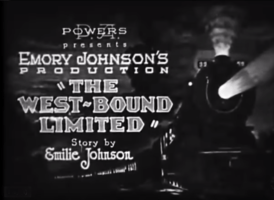
The third film in the FBO contract was The West~Bound Limited. Emilie wrote both the story and screenplay. The story is about railroad engineer Bill Buckley who narrowly avoids injuring the daughter of the president of the company by stopping his speeding train just in the nick of time. Various misfortunes ensue, Bill's son saves the daughter, and everybody lives happily ever after.[24][25]
.png)
The fourth film in the FBO contract was The Mailman. Emilie wrote both the story and the screenplay.[26] The film provides an excellent example of melodrama and displays Emilie's flair for this genre.
This story unfolds as veteran postman Bob Morley (played by Ralph Lewis) and his son Johnnie (played by Johnnie Walker) are both honored for their years of service. Johnnie receives a promotion to work on a postal service ship, the Enterprise, which carries registered postal mail. A robbery occurs one night on the ship. The robbers kill a postal officer, which Johnnie witnesses. The perpetrators throw him, the only witness, overboard into the sea.
Johnnie is recovered by a yacht that happens to be in the area. In a twist of fate, the vessel is a rum-runner and happens to be involved in the robbery of the Enterprise. Johnnie alerts the Pacific fleet. The entire fleet pursues the rum-running yacht with ten dreadnoughts. The warships destroy the 90-foot yacht. Johnnie is saved from the destruction, only to face trial for killing a government postal officer during the robbery. His father desperately contacts everyone he knows, pleading to save his son. As the court is about to sentenced Johnnie to hang for the shooting, the real perpetrator confesses, and all ends well.[27][28]
In September, Emilie and Emory signed a new contract with FBO. The contract was for 2½ years. Emory Johnson agreed to make eight attractions for FBO, including the four he had completed already. FBO agreed to invest upwards of two and one-half million dollars (equivalent to $37,514,648 in 2019) in the forthcoming productions.[29] Another part of the signed contract stipulated: "The contract also provides that Emory Johnson's mother, Mrs. Emilie Johnson, shall prepare all of the stories and write all the scripts for the Johnson attractions in addition to assisting her son in filming the productions."[29]
1924
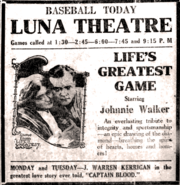
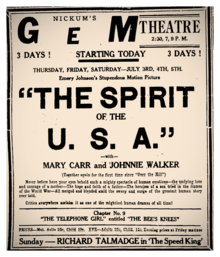
Emilie started the year by writing the story for the fifth FBO film, Life's Greatest Game, released in May. This story is about America's greatest pastime, baseball. The Black Sox Scandal provided inspiration for the section of the movie regarding the throwing of a World Series. The rest of the film features crooks, illicit affairs, the spectacular sinking of the Titanic, romance, and a middle-aged father uniting with his long-lost son.[30][31]
Emilie finished the year with the sixth film in this series, The Spirit of the USA, released in December. She wrote both the story and the screenplay. She claimed Woodrow Wilson inspired this story about World War I.[32] The movie has scenes of European battlefields, a spectacular scene of a dam blowing up, a mother's love for her sons, betrayal, and skullduggery. Both sons end up going to Europe, but only one returns. Everyone thought he had died in battle. After his return, he restores order to those who were hoodwinked and lost their property. He marries his sweetheart, and they live happily ever after.[32][33][34]
1925

The seventh film in the FBO contract was The Last Edition, released in October. Emilie wrote the story for their only production of the year. This was the "last hurrah" for the working man series of movies.
The story starts when Tom McDonald, assistant foreman of the San Francisco Chronicle pressroom, is passed over for the job of press foreman. He takes solace that his son Ray has a good job in the district attorney's office. Reporter Clarence loves Tom's daughter Polly. Clarence is currently working on a story about a gang of bootleggers. To put Clarence off their track, the bad guys' frame Ray on a bribery charge. Clarence reports the trumped-up charge to the Chronicle in time to make the last edition. Just as the story is about to hit the presses, Dan finds out. He attempts to shut down the machinery so they will be unable to print the story. He fails and is thrown into jail with his son. Meanwhile, the plant is burned down, and Dan receives the blame. Clarence and Polly eventually uncover evidence exonerating father and son. Tom becomes the new foreman, they build a new plant, and Clarence marries Polly.[35][36]
1926
The year started with tragedy. Emilie's grandson was run over by a truck and killed in Los Angeles. Alfred Bernard Johnson was only five years old when he died in March 1926. He was Emilie's second oldest grandson.[37]
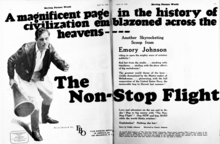
In March, Emory and Emilie Johnson released their last picture for FBO, The Non-Stop Flight.[38][39] The story starts out in 1906 Sweden. A sea captain, Lars Larson, returns home from a long voyage. He discovers his wife and child kidnapped. He goes mad and becomes a smuggler.
Fast-forward to 1925, when the Navy is conducting its history-making nonstop flight from San Francisco to Hawaii. A fuel shortage forces the plane down in the Pacific. The PN9 drifts to an uncharted island. Once the crews travel to the island, they find a hermit and a beautiful woman. The crew's second in command falls in love. Captain Lars happens to be on the island at the same time. A conflict breaks out between smugglers, flyboys and Chinese coolies. A US submarine arrives in the nick of time to rescue the downed plane and restores order. Captain Lars finds out the woman is his missing daughter and the plane's number two gets the girl.
This same year, Emory and Emilie were working on a movie titled Happiness. Work had supposedly started in December 1925. Emory, Emilie, and cast and crew had sailed for Sweden to film the movie. The fate of the movie remains unknown.[40]
In April, FBO decided to let Emory and Emilie Johnson's contracts expire. No reason was published regarding the expirations.[41]
In June, Emory and his mother signed a new eight-picture deal with Universal.[42]
1927

Emilie was now approaching 60 years old, while Emory was still in his thirties. In March, Universal released the Fourth Commandment. Emilie wrote the story. This tale starts by showing a devoted son living with his mother and his wife. His wife becomes jealous of her mother-in-law's devotion to her son. She orders his mother to leave home. They eventually get divorced, and she marries a millionaire. They have a son. Her husband goes broke, and she loses everything. The disgraced divorced wife is forced to move in with her son and his wife. The circle is now complete; she starts to experience the same hardships her first mother-in-law had endured.[43]
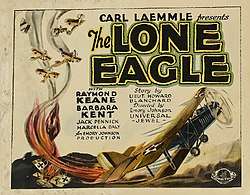
In September, Emilie "assisted" in the writing of The Lone Eagle, according to the credits.[44][45]
This Emory Johnson movie is a World War I aviation film. Billy is an American aviator who gets an assignment to the Royal Fling Corps. The unit is located on the western front and sees plenty of action. During one encounter with the enemy, Billy is accused of cowardice. Then he meets Mimi, a French girl. She inspires him to prove his bravery in battle. During the next air skirmish, Billy's best friend shoots down a German ace, but is killed in the process. The German aviator's brother, upset over his sibling's death, challenges the Allies to a sky duel. After loads of action, Billy shoots the German ace down. After the Armistice is signed, Billy marries Mimi, they return to the United States.
1928
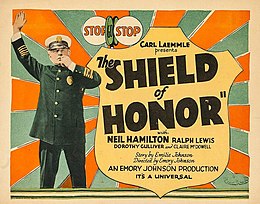
In February, Universal released The Shield of Honor. Emilie wrote the story. This film starts out when veteran policeman Dan MacDowell and his son Jack are honored at an event celebrating the addition of an airplane to the police force. Jack will become the plane's first pilot. Gwen, the daughter of a wealthy jeweler, christens a plane. Jack and Gwen immediately fall in love. Her father asks Jack to help him solve the jewel robberies of his customers. Jack investigates and narrows the search to Gwen's father's business partner. Another robbery is committed, and Jack knows who did it. Jack and his father jump into the police plane, pursue the criminals and fight a night air battle. The jewel thieves are captured. Jack and Gwen live happily ever after.[46][47]
After completing three fairly successful movies for Universal, the Johnson team jumped ship, reneged on their eight-picture contract and signed with another company. Emory and his mother negotiated a new contract with Poverty Row studio Tiffany-Stahl Productions.[48][49]
Major chunks of 1929 were spent with Emory trying to reunite with Ella Hall and repair their marriage. Because they had lost Alfred Bernard in 1926, Emory and Ella decided to have one last child. Emilie's granddaughter Diana Marie (Dinie) was born in October 1929.[50]
1930–1932
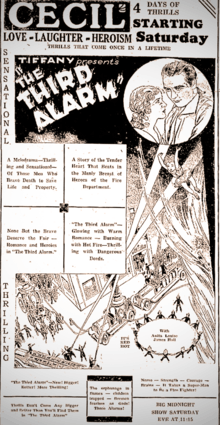
In November 1930, Emory Johnson released his first Tiffany-Stahl Productions contract production, The Third Alarm. This film would become his first talkie. Although the name of this film was the same as the 1922 version, the similarity ended there.
This remake is a family drama about a young heroine and her younger brother who are orphaned when their father is killed in a fire. A hero emerges who tries the children from going to an orphan asylum. A fire starts at the orphanage and the children must be saved. After saving them, the hero realizes he is in love with one of the orphans. They get married and live together with her brother.
Emilie's original story is the basis for this film, but the similarity only extends to both stories being about firefighters. The screenwriting duties of this version of The third Alarm were assigned to another T-S writer, Frances Hyland.[51][52]
A significant news item appeared on Page 4 of the September 4, 1930 edition of Variety Magazine.[53]
Emory Johnson, engaged by Tiffany to direct "The Third Alarm" on the strength of his silent of the same title for FBO; has been off the picture since the first day's shooting. Martin Cohn, the editorial supervisor at Tiff, is finishing it, although direction credit will go to Johnson, beside a piece of the picture. Johnson objected to the supervision.
The Third Alarm was the last film Emory Johnson made for Tiffany. Emory Johnson signed a new contract with another Poverty Row studio – Majestic Pictures.
In August 1932, Emory Johnson released his last film, Majestic Pictures' The Phantom Express. Emilie received a story credit.
Emory Johnson tried to recreate the success of his previous railroad film, The West~Bound Limited. The first railroad film was a silent, but this was a talkie. This story starts with engineer Smoky Nolan speeding down the tracks at full throttle when he spies an oncoming train directly in his path. He quickly applies the emergency brakes and the train starts screeching to a halt, but then derails. Several passengers are killed. Nobody can find any trace of the oncoming train causing the derailment, and Smoky is fired.
Smoky has a beautiful daughter, Carolyn, and the CEO of the Southwest Pacific Railroad has a playboy son - Bruce. Boy meets girl, and they both set out to find the mystery of the phantom express. During their investigation, they uncover a diabolical scheme concocted by a network of bad guys. Because of the accidents, the bad guys want to purchase the railroad at a reduced cost. Bruce discovers the plot just hours before his father is going to sign the railroad over to the bad guys. The telegraph is down because of a storm, and the only way to advise his father is to have old 101 engineered by Smoky Nolan transport Bruce back to the central office so he can personally warn his father not to sell. The train must travel through floods, landslide, and other hazards. They make it just in time to nix the deal. Bruce and Carolyn hook up and honeymoon on the train.
This was the curtain call for Emory's independent directing years, along with Emile's collaborative writing.[54][55] Emory was contracted to make one last picture for Majestic, Air Patrol, but the project never came to fruition.[56]
Final chapter
In 1930, Emile Johnson turned 63 years old. Two years later, Emory Johnson filed for bankruptcy.[57] Emilie and Emory sold the house on Franklin Avenue where Emory, his mother, Ella Hall, and all the kids had lived. Emory and his mother moved to a new house on Killion street sometime after 1930.[58] Emory became a portrait photographer in Los Angeles and eventually relocated to San Mateo, California. He died in 1961.
After 1932, Emilie's movie writing career was over. This last decade of her life was unremarkable. It closed with her death on September 23, 1941, at the age of 74 in Los Angeles, California.
Family
Emilie Johnson was married to her only husband Alfred and had one son, Emory Johnson. Emilie had four grandchildren after her son married Ella Hall:
- Walter Emory Jr, born in 1919, changed his name to Richard Emory and had an acting career in B Movies
- Alfred Bernard, born in 1920, died in 1925
- Ellen Joanna, born in 1923, changed her name to Ellen Hall and had an acting career in B movies
- Diana Marie, born in 1929, became a housewife
Themes
J. I. Schnitzel on Emory Johnson new contract signed FBO[59]
Emilie Johnson wrote stories about law enforcement officers, firefighters, mail carriers, railroad engineers, patriots, baseball players, and newspaper pressmen. Her son brought them to the screen in epic melodramas. Nobody else had written screenplays about the everyday working joes. The Johnson team felt their human-interest stories would be relatable on the silver screen.
Emory had also earned the title of "King of Exploitation." The moniker was good for advertising but not truly earned. As the quote box shows, "His pictures will be made for exploitation." The exploitation angle was not the brainchild of the Johnsons. FBO's Nat Rothstein hatched the exploitation strategy for all the Johnson movies. An example of this strategy can be seen at In the Name of the Law - Exploitation.[60][61]
Quotes
For the author, the world is your oyster.[62]
I would much rather write for the screen than for the stage or the publisher.[62]
The greatest appeal in pictures is not in extravagant spectacles, historical pageants or adaptation of fairy tales. I think the straight-forward, clean, wholesome melodrama will always have the choice corner in the hearts of the American public."[62]
Throughout my work, I have followed one rule which I think is successful. It is the combining of emotion with humor - making a laugh follow a scene of pathos.[2]
Emilie discussed "The Third Alarm" with the newspaper - "When creating a third alarm, I took every possible opportunity to visit the engine houses of the fire department, watching the actions of the firemen and observing the procedure in answering an alarm. Emory is always with me on these occasions, and we are in consultation daily in regard to angles of the story that present themselves as a result of our observations. Together we attend the fire chief's convention at San Francisco."[63]
Selected film credits [64]
| Year | Film | Producer | Distributor | Credits * | Notes |
|---|---|---|---|---|---|
| 1921 | Blind Hearts | Hobart Bosworth | Associated Producers | Story | [65] |
| 1921 | The Sea Lion | Hobart Bosworth | Associated Producers | Story | [66][67] |
| 1922 | In the Name of the Law | Emory Johnson | FBO | Story, screenplay | [68] |
| 1922 | The Third Alarm | Emory Johnson | FBO | Story | [69][70] |
| 1923 | The West~Bound Limited | Emory Johnson | FBO | Story, screenplay | [71][72] |
| 1923 | The Mailman | Emory Johnson | FBO | Story, screenplay | [73] |
| 1924 | The Spirit of the USA | Emory Johnson | FBO | Story, screenplay | [74][75][76] |
| 1924 | Life's Greatest Game | Emory Johnson | FBO | Story | [77] |
| 1926 | The Last Edition | Emory Johnson | FBO | Story, screenplay | [78][79] |
| 1926 | The Non-Stop Flight | Emory Johnson | FBO | Story, screenplay | [80][81][82] |
| 1927 | The Lone Eagle | Universal Pictures | Universal Pictures | Adaptation | [83] |
| 1927 | The Shield of Honor | Universal Pictures | Universal Pictures | Story | [84][85][86] |
| 1927 | Fourth Commandment | Universal Pictures | Universal Pictures | Story | [24][87][88] |
| 1930 | The Third Alarm | Tiffany Productions | Tiffany Productions | Story | [89][90] |
- Based on WGA screenwriting credit system
References
- "Famed Movie Producer Lives Quietly in S.M. He Loves". The Times (San Mateo, California). July 25, 1959. p. 21 – via GenealogyBank.com.
- "This Writer Has Produced 19 Scenarios Tells How She Began Weaving Plots for the Silver Screen". Riverside Independent Enterprise. May 14, 1922. p. 5 – via GenealogyBank.com.
- "United States Census, 1900". Ancestry.com. June 6, 1900. Provided in association with National Archives and Records Administration
- "United States Census, 1910". Ancestry.com. April 16, 1910. Provided in association with National Archives and Records Administration
- "ESSANAY CLOSE-UPS". The New York Clipper. January 1914. p. 65.
- "The Last Edition". San Francisco Silent Film Festival. Retrieved February 12, 2018.
- "Exposition City Gleanings". The Moving Picture World. New York, Chalmers Publishing Company. October 1915. p. 1006.
- Anthony Slide (February 25, 2014). The New Historical Dictionary of the American Film Industry. Routledge. p. 116. ISBN 978-1-135-92554-3.
- "A SHORT HISTORY OF ESSANAY FILM COMPANY IN NILES". Nilesfilmmuseum.org. Retrieved March 12, 2019.
- "Liberty Plant, In Philadelphia, Wiped Out by Fire". Motion Picture News. Publisher Exhibitors' Times, inc. April 22, 1916. p. 2328.
- "Film Fire cost $150,000". Motography. Electricity Magazine Corp. April 22, 1916. p. 918.
- "Plays and Players". Photoplay. Chicago, Photoplay Magazine Publishing Company. September 1917. p. 111.
- "Cupid Note". Los Angeles Times. September 7, 1917. p. 15 – via Newspapers.com.
- "United States Census, 1920". Ancestry.com. January 16, 1920. Provided in association with National Archives and Records Administration
- Progressive Silent Film List: Blind Hearts at silentera.com
- Blind Hearts on IMDb
- "The Sea Lion (1921)". IMDb. Retrieved March 20, 2019.
- "The Sea Lion (1921) - Rowland V. Lee | Synopsis, Characteristics, Moods, Themes and Related". AllMovie. Retrieved March 20, 2019.
- "R - C Plans Distribution Under New Name July 1". Motion Picture News. New York, Motion Picture News, Inc. June 24, 1922. p. 3316.
- "In the Name of the Law (1922)". IMDb. Retrieved March 20, 2019.
- In the Name of the Law the AFI Catalog of Feature Films
- "The Third Alarm (1922)". IMDb. Retrieved March 20, 2019.
- The Third Alarm The AFI Catalog of Feature Films
- "Westbound Limited (1923) - Emory Johnson | Synopsis, Characteristics, Moods, Themes and Related". AllMovie. Retrieved March 20, 2019.
- "The West~Bound Limited @ TCM.com". tcm.com. Retrieved March 20, 2019.
- "Originator of "The Mailman" reveals Story". San Francisco Chronicle. December 15, 1923. p. 8 – via GenealogyBank.com.
- TheMailman The AFI Catalog of Feature Films
- "The Mailman (1923)". IMDb. Retrieved March 20, 2019.
- "F.B.O. Signs Emory Johnson for Eight Productions". Motion Picture News. New York, Motion Picture News, Inc. September–October 1923. p. 1185.
- Greatest Game Emilie Johnson at the American Film Institute Catalog
- Life's Greatest Game at AllMovie
- "Idealism of Woodrow Wilson Inspired Theme of New Film". The Moving Picture World. by Moving. March 1, 1924. p. 31.
- "The Spirit of the USA @ TCM.com". tcm.com. Retrieved March 20, 2019.
- "Spirit of the USA (1924) - Emory Johnson | Synopsis, Characteristics, Moods, Themes and Related". AllMovie. Retrieved March 20, 2019.
- "The Last Edition @ TCM.com". tcm.com. Retrieved March 20, 2019.
- "The Last Edition (1925) - Emory Johnson | Synopsis, Characteristics, Moods, Themes and Related". AllMovie. Retrieved March 20, 2019.
- "Truckman is Held in Death of Child". Los Angeles Times. March 28, 1926. p. 122 – via Newspapers.com.
- "The Non-Stop Flight @ TCM.com". tcm.com. Retrieved March 20, 2019.
- "The Non-Stop Flight (1926) - Emilie Johnson, Emory Johnson | Synopsis, Characteristics, Moods, Themes and Related". AllMovie. Retrieved March 20, 2019.
- "F.B.O. Features Are Under Way". Motion Picture News (Nov–Dec 1925). Motion Picture News, Inc. December 19, 1925. p. 3013.
- "Emory Johnson leaves F.B.O." The Film Daily. April 18, 1926. p. 2.
- "Hollywood Studio Gossip". San Francisco Chronicle. June 4, 1926. p. 11. Retrieved March 11, 2019 – via GenealogyBank.com.
- "Entire Issue dedicated to the Fourth Commandment". Universal Weekly. Universal Pictures. October 30, 1926. pp. 46–89.
- "The Lone Eagle (1927) - Emory Johnson | Synopsis, Characteristics, Moods, Themes and Related". AllMovie. Retrieved March 20, 2019.
- "The Lone Eagle @ TCM.com". tcm.com. Retrieved March 20, 2019.
- "The Shield of Honor (1927) - Emory Johnson | Synopsis, Characteristics, Moods, Themes and Related". AllMovie. Retrieved March 20, 2019.
- "The Shield of Honor @ TCM.com". tcm.com. Retrieved March 20, 2019.
- "Johnson and McCarthy Reported with T.-S". The Film Daily. New York, Wid's Films and Film Folks, Inc. January 16, 1928. p. 125.
- "Johnsons Join T-S as Writing, Directing Team". The Film Daily. New York, Wid's Films and Film Folks, Inc. February 14, 1928. p. 324.
- "California Birth Index, 1905-1995". Ancestry.com. 2005. Provided by State of California Department of Health Services, Center for Health Statistics.
- "The Third Alarm (1930)". IMDb. Retrieved March 20, 2019.
- "The Third Alarm (1930) - Emory Johnson | Synopsis, Characteristics, Moods, Themes and Related". AllMovie. Retrieved March 20, 2019.
- "Objected to Supervision". Variety. September 4, 1930. p. 4.
- "The Phantom Express (1932)". IMDb. Retrieved March 20, 2019.
- "The Phantom Express @ TCM.com". tcm.com. Retrieved March 20, 2019.
- "Majestic has 26 lined up for the new season". Motion Picture Herald. Quigley Publishing Co. July 23, 1932. p. 50.
- "Emory Johnson Broke". Variety. Mar 8, 1932. March 8, 1932. p. 10.
- "United States Census, 1940". Ancestry.com. April 24, 1940. Provided in association with National Archives and Records Administration
- "Johnson To Make 8 for FBO". Motion Picture News. Motion Picture News, Inc. December 19, 1925. p. 166.
- "Nat Rothstein Compiles Best Campaign Book". Exhibitors Herald. August 26, 1922. p. 50.
- "Rothstein Conducts Record Ad Campaign". Exhibitors Herald. Chicago, Exhibitors Herald. July 29, 1922.
- <"Plays and Players". Stamford Daily Advocate. October 18, 1924. p. 16 – via GenealogyBank.com.
- "Visit railroad shops in search of local color". The Butte Miner (Butte, Montana). June 17, 1923. p. 10 – via Newspapers.com.
- "Catalog of Copyright Entries-Cumulative Series". Motion Pictures. Library of Congress, Copyright Office. 1912 - 1939. 1951.
- "The Library of Congress American Silent Feature Film Survival Catalog: Blind Hearts". 1921.
- "The Library of Congress American Silent Feature Film Survival Catalog: The Sea Lion". 1921.
- "The Sea Lion available for download at Internet Archive". January 1921.
- "The Library of Congress American Silent Feature Film Survival Catalog: In the Name of the Law". 1922.
- "The Library of Congress American Silent Feature Film Survival Catalog: The Third Alarm". 1922.
- "The third Alarm is available on You Tube".
- "The Library of Congress American Silent Feature Film Survival Catalog: The Westbound Limited". 1923.
- "The Westbound Limited is available on You Tube".
- "The Library of Congress American Silent Feature Film Survival Catalog: The Mailman". 1923.
- "The Library of Congress American Silent Feature Film Survival Catalog: The Spirit of the U.S.A.". 1924.
- "The Spirit of the U.S.A. is available for download at Internet Archive". 1924.
- "The Spirit of the USA available on You Tube (15 minute excerpt)".
- "The Library of Congress American Silent Feature Film Survival Catalog: Life's Greatest Game". 1924.
- "The Library of Congress American Silent Feature Film Survival Catalog: The Last Edition". 1925.
- "Informative website dedicated to The Last Edition restoration".
- "The Library of Congress American Silent Feature Film Survival Catalog: The Non-Stop Flight". 1926.
- "Complete movie available on DVD from video distributor)".
- "Excerpt of the Non-Stop Flight available on You Tube".
- "The Library of Congress American Silent Feature Film Survival Catalog: The Long Eagle". 1927.
- "The Library of Congress American Silent Feature Film Survival Catalog: The Shield Of Honor". 1927.
- "Copies of film exist at Eastman Collection".
- "Copies of film exist at UCLA Archive".
- "The Library of Congress American Silent Feature Film Survival Catalog: The Fourth Commandment". 1927.
- Fourth Commandment at the AFI Catalog of Feature Films
- The Third Alarm details @ IMDb.com]
- The Third Alarm synopsis at AllMovie